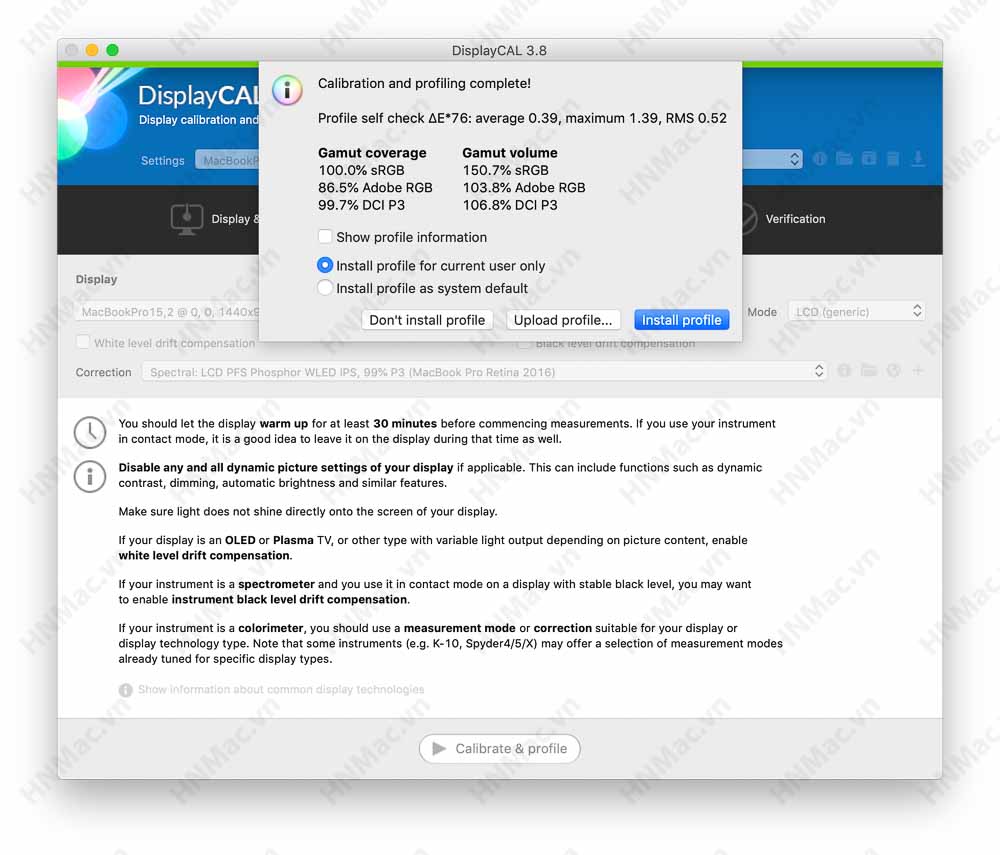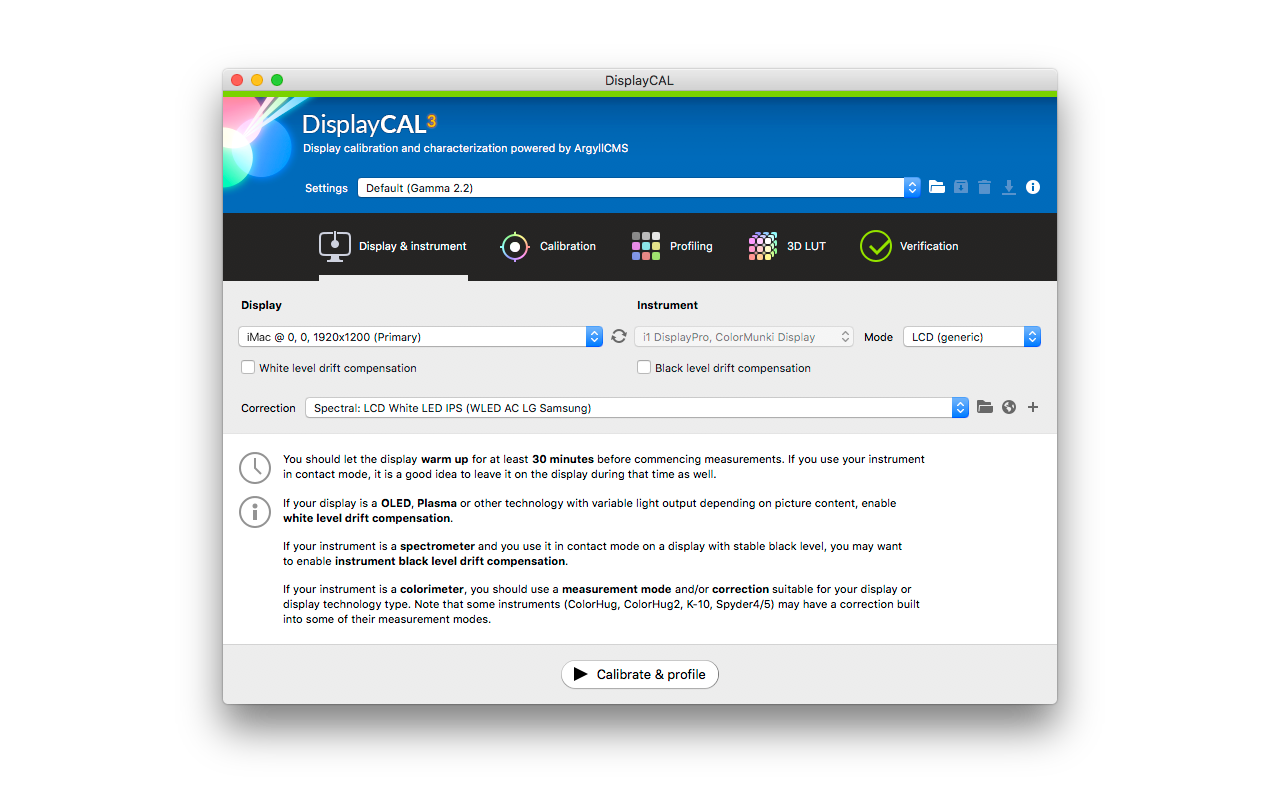
Displaycal For Mac
Is a place to politely discuss the tools, technique and culture of photography.This is not a good place to simply share cool photos or promote your work, but rather a place to discuss photography as an art and post things that would be of interest to other photographers. Please be sure to read before posting.
DisplayCAL (formerly known as dispcalGUI) is an Argyll CMS based application that can be used to profile and calibrate displays. You can easily calibrate and characterize displays using one of the supported hardware sensors. Also, DisplayCAL also includes support for colorimeter correction via correction matrices or calibration sample files.

No Image Link PostsPosting images is only allowed as self-post using the photo as an example for the discussion, either to begin a general conversation about some aspects of the example or to ask a photography-related question. The image should be linked within the text of the self-post and be used in support of an overall topic/question rather than the focus of the post.If you just want to share an image you've taken, you're welcome to post in, our sister photo sharing sub.2. The Official Questions ThreadQuestions asking for help (including equipment purchasing advice) should be posted as comments in the most recent Official Question thread, stickied at the top of the subreddit. Before posting, please check our extensive FAQ, your question may already have been answered! When seeking purchase recommendations, please be specific about how much you can spend. (See for guidelines.)If you do not wish to post your simple questions to the Official Questions thread we cordially invite you to post your question to, they love questions as standalone posts!Interesting discussion/questions on broader topics may be permitted as self posts at the discretion of the moderators. Post titles must include details as to the subject of the post.3.
Community ThreadsWant to talk about some fun or interesting projects you're working on? Got some new (or new-to-you) gear you want to share? Looking to bounce some ideas off of other people for things you want to try? Post in the most recent Community Discussion thread.4. Lost and FoundIf you've lost or found a piece of photography equipment, please head over to the.5. Meta PostsMeta discussion about the subreddit itself should be directed to.6.
No Classified AdvertisementsIf you want to sell a photography item to redditors or want to buy a photography item from a redditor, please use. If you just want to share some great photography-related deals, post in the.7. No Spam or Self-promotionWe do not allow blogspam, ads, shortlinks, seeking votes for contests, referral links, crowdsourced funding, circlejerking, karmawhoring, surveys and/or market research, or DAE/ITAP posts.8. No Social Media RantsThis is not the place to complain about popular trends on social media that you don't like. Is not /r/Instagram or /r/Facebook (or a place that's at all specific to any other platform), and as such it's not a place to make posts complaining about those platforms or whatever subjective content happens to be popular at the moment.9. Keep it CivilNo personal attacks of any kind. Violations may result in a ban.10.
User FlairsUse the flair system only for your portfolio and nothing else! Spinoza ethica latin pdf. Not allowed for example: Gear, blogspam, shortlinks.Useful Links:.Info Threads:. Wedding: Yes or No?. Photography School: Yes or No?. Work for Free: Yes or No?.
Watermarks:Official Threads:.Meta Links:Affiliate Links.Shopping using these links generates cash for projects, such as prizes for our competitions. Search posts by flair.Live chat IRC veterans: connect to irc.snoonet.org:6667 and join #photography. Hi there,a few months ago we had a discussion on using DisplayCAL over the Spyder software to calibrate your screen, people were saying that DisplayCAL does a far better job than the Spyder software.Since I calibrated with DisplayCAL for the first time, there is no way I would go back using the Spyder software.I put some effort in and wrote a quite (4 or 5 doesn't matter).Take me easy on the lighting part tho, I'm by no means a professional and just try to reflect what I learned myself, happily taking corrections in the article from you guys.Maybe this is useful for someone. I think saying that 5000k as a 'print standard' color temperature is erroneous. What are you basing this off? This will vary from printer to printer and paper to paper.
There is no 'standard.' Just for instance, I base my display profiles off of prints made on Epson Luster (run of the mill 'average' paper) made on an Epson 9900. This combination has led me to use 6500k as a display color temperature as it yields the most accurate results. However, when i'm printing on different paper (maybe a stock without OBA's) this temperature only yields a passable result, so more fine tuning is necessary.tl;drThere are too many factors at play to say 5000k is a standard.Edit: I mean 5500k. Yeah, as I said, don't take my word on lighting for a 100%, I just reflected what I learned.I did an apprenticeship as a printer. Excerpt:The solution for soft proofing started to become clear. The printing industry would continue to use D50 illumination as the standard for viewing contract proofs.
The graphic artists would use color CRT monitors calibrated to a D65 white point because the D65 white point would allow them to achieve complete chromatic adaptation. However, in order for this to work, the image on the monitor could not be directly compared to a print under D50 illumination in a side-by-side viewing environment. The observer would have to have time to fully adapt to each separate viewing environment.Therefore, the right white point for monitor calibration is D65 in order for the viewer to achieve complete chromatic adaptation to the color monitor based on sensory mechanisms in human vision—cognitive mechanisms are not active. Since cognitive and sensory mechanisms are both active when a print is viewed, the viewer should not directly compare a print to an image on a computer monitor when the white point for the illumination of the print is different from the white point of the color monitor.
Customers can sometimes experience poor results, unexpected results, color casts, or bad results with an i1Display Pro monitor profile on a MacIf a display profile produces poor results (color cast, low contrast, high contrast, low luminance, etc..), try reprofiling after making sure to check the following:· Connect the measurement device to a properly powered USB port. Typically, a tower will have rear ports that more reliably and consistently deliver the required power to the device.
· Avoid using USB ports on keyboards and monitors. Also avoid unpowered USB hubs as well as USB extensions.
· An acceptable extension is the use of a powered USB hub. Some laptop computers will require a powered USB hub to deliver the necessary power.
· PLACE THE MEASUREMENT DEVICE FLUSH ON THE SCREEN WHEN PROFILING! This will more easily be accomplished tipping the display back and carefully place the device on the screen while viewing from the side. An instrument that is not flush on the screen’s surface will result in bad measurement data and then poor results when using the profile. Do not push on the device while measuring as pressure can change color on LCD screens.
· Consider turning off all anti-virus and/or firewall software when profiling.
· Laptops must have the power supply connected when profiling.
Next, please do the following in exactly this order:
- Go to System Preferences > Accessibility and select the “Display” option on the left. Make sure that the “Display Contrast” slider is set all the way to the left at “Normal”. Make sure that 'Reduce transparency' is the only item checked just above the contrast slider.
- Now go to the Applications folder and right-click (or control-click) on the i1Profiler application icon and click on “Show Package Contents”
- Navigate to Contents > MacOS > Profiles and then copy and paste the “XRite_LinearProfile.icc” profile to the Mac HDLibraryColorSyncProfiles folder. Close Finder.
- Open “Displays” in System Preferences and select the “Color” tab. Click on the profile named “DisplayProfile_Linear.icc” to reset your display’s RGB channels to a linear fashion. The onscreen color should change and will likely look bad.
- Close Displays and System Preferences.
- Connect the i1Display Pro and open the i1Profiler software application.
Turn off “ADC” (Automatic Display Calibration) when profiling in the Advanced Mode of i1Profiler. Automatic Display Control (ADC) can sometimes produce unsatisfactory results. Follow these instructions to turn “ADC” off:
1. Typically, users should select a white point of “D65”, a luminance setting of “120”, and “Native” for contrast ratio. Select “White LED” for your Technology Type if it is an Apple display manufactured after 2009. If this is the new 4K 21.5' or 5K 27' Retina iMac manufactured in Late 2015 or later, select 'GB-LED (RG Phosphor)' for the Technology Type.
2. In the “Measurement” step, select the “Adjust brightness, contrast, and RGB gains manually”. This will unselect 'Automatic Display Control (ADC)'
3. Uncheck the contrast and RGB options as those controls are not manually adjustable on an Apple monitor. DO NOT unselect the option to adjust brightness manually…this must remain selected. When adjusting brightness on an Apple display (iMac, MacBook, or Apple displays), you may need to open System Preferences > Displays to fine tune the brightness to more closely match the target.
4. Click “Next” to save these settings and begin the profiling process.
5. Create a new display profile. When you create and save the profile, save it with a unique name. Perhaps you can add the month and year to the name (i.e., iMac_Feb2014.icc). You will need to retain the “.icc” extension.
The recommended display profiling settings of a D65 white point, 2.2 gamma, and 120cd/m2 has been set by the industry experts. The photographers and graphic designers of the world have determined that a monitor profiled to these parameters will most closely match a print that is viewed in a 5000K light booth (Graphic arts standard). The default gamma (aka; tone response) is set at 2.2 in the Profile Settings step. We recommend using the Advanced method and select a luminance of “120”. If your prints are darker than your display, feel free to try a lower display luminance setting of 100, 90, or even 80.